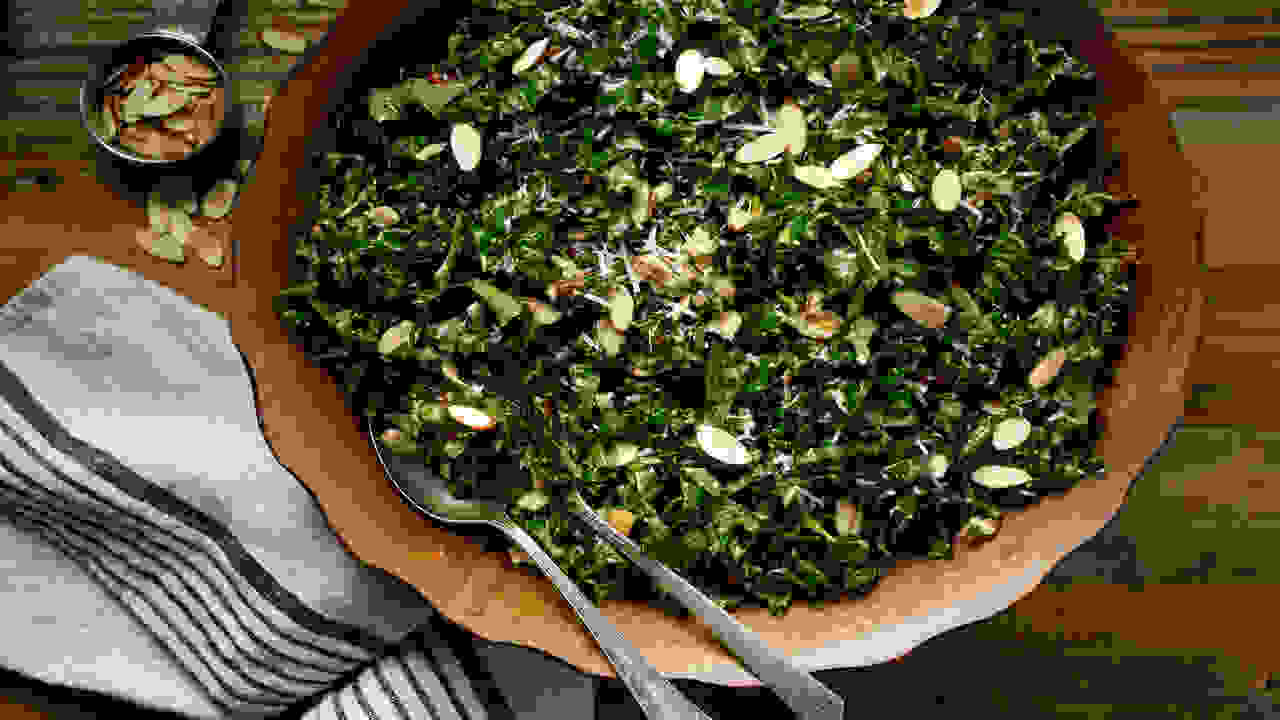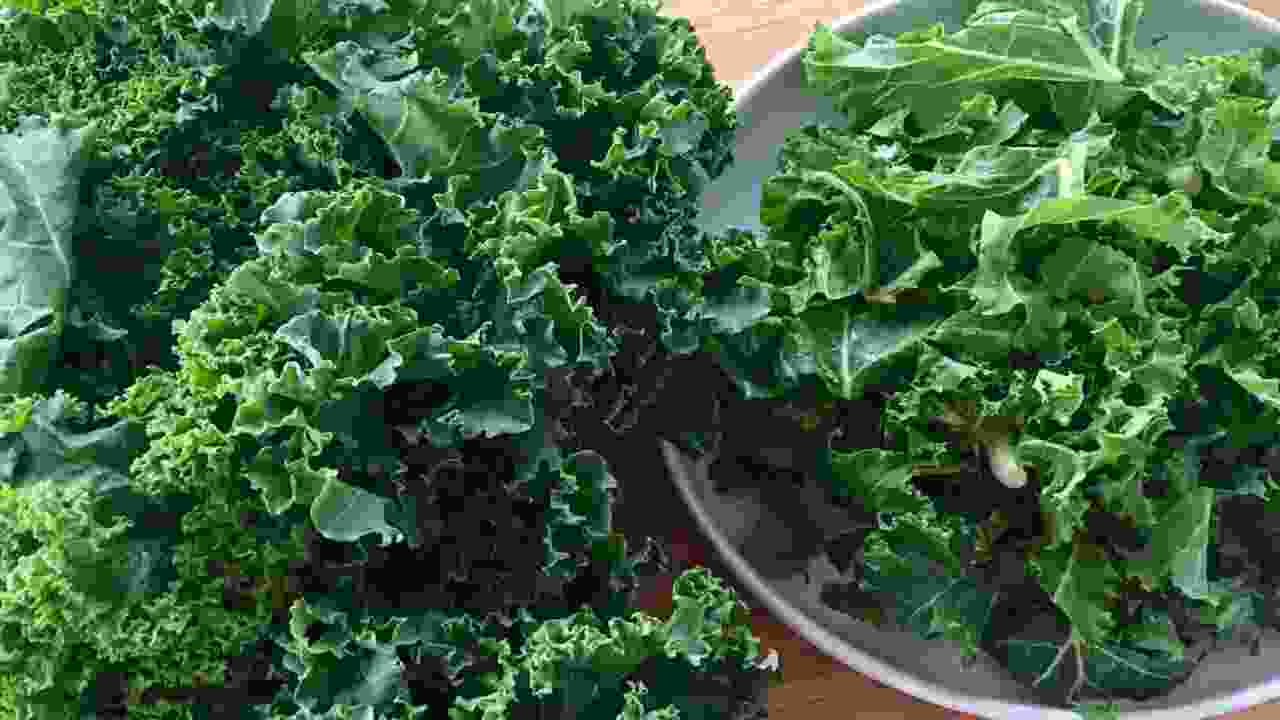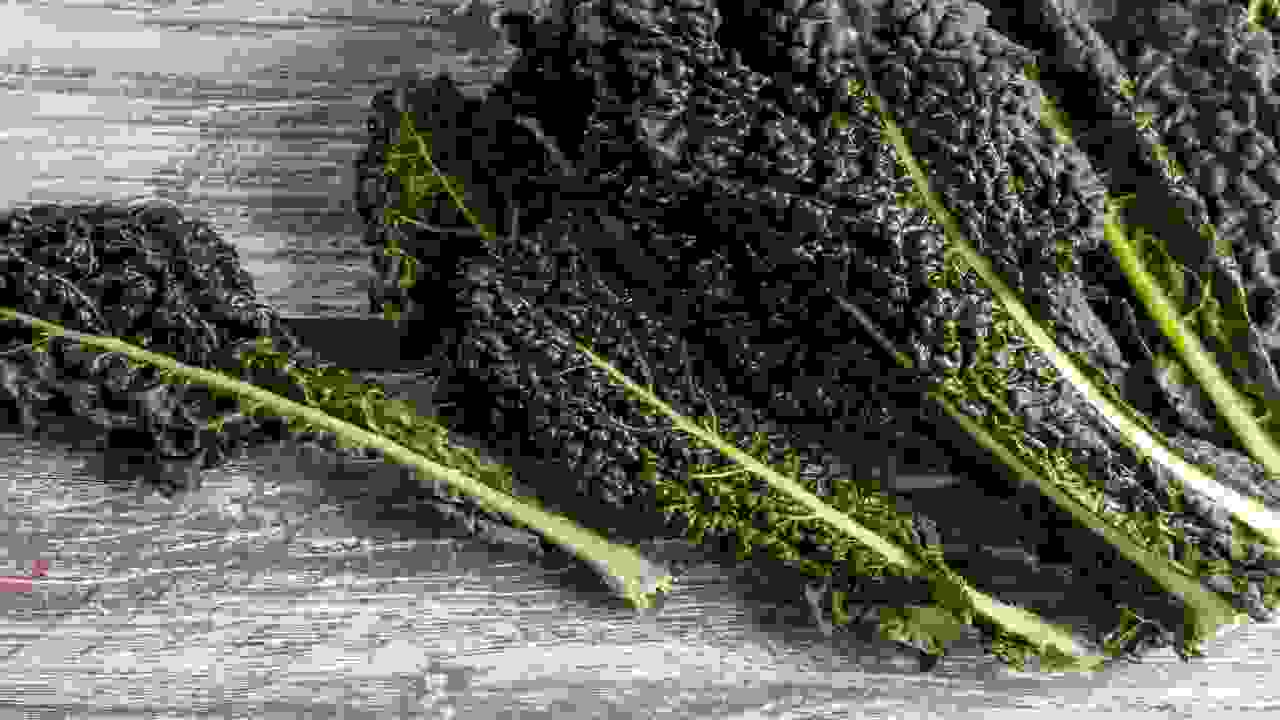Kale is a cruciferous vegetable popular for its nutrient content and delicious taste. It’s a Member of the Chenopodiaceae family and has many health benefits, including reducing the risk of cancer and heart disease.
Knowing the exact measurement of a bunch of kale is crucial when following recipes or trying to incorporate a specific amount into your meals. Whether you’re a cooking enthusiast or simply curious about the proper portion size, understanding how many cups of kale are in a bunch will help you make the most of this nutritious leafy green.
If you’re a fan of kale and enjoy adding it to your meals, you might be wondering how many cups are in a bunch of this leafy green. While it may seem simple, the answer can vary depending on certain factors. We’ll discuss the different types of kale, how to measure a bunch of kale, and which is the best way to store it.

Contents
- 1 Let’s Know How Many Cups In A Bunch Of Kale?
- 1.1 Factors Affecting The Number Of Cups In A Bunch Of Kale
- 1.2 Measuring A Bunch Of Kale
- 1.3 Average Number Of Cups In A Bunch Of Kale
- 1.4 Is a Bunch Of Kale A Pound?
- 1.5 How Much Is A Bunch?
- 1.6 How Many Bunches Are In A Case Of Kale?
- 1.7 What Is A Bunch Of Kale In Cups?
- 1.8 How To Cut Up Kale For Salads Or Cooking
- 1.9 Tips For Accurately Measuring Kale For Recipes
- 1.10 Storing Leftover Kale For Future Use
- 1.11 Frequently Asked Questions [FAQs]
- 1.12 How much kale is in a bunch?
- 1.13 How much kale is in a cup?
- 1.14 Is a cup of kale enough?
- 1.15 Can I eat 2 cups of kale a day?
- 1.16 Is it OK to eat raw kale?
What Is A Bunch Of Kale
Generally, a bunch of kale consists of several individual leaves bound together at the stems. A bunch is a stem of kale or lettuce used as a recipe ingredient. A “bunch” can be 6-12 leaves, depending on how tight the square of the leaves are.
A single leaf is never 6-12 because a single leaf is not wide enough, and therefore, you can’t fit a bunch of them into something. Firmer kale refers to a specific type of kale with a denser texture than other varieties.
We always tell people to measure their food or know the measurements of your measuring cups/spoons used in recipes. A “bunch” has three separate piles: 3-5 stems at 2 leaves per stem and 1 -2 massive fistfuls with 5 roots.
Let’s Know How Many Cups In A Bunch Of Kale?

When measuring kale for a recipe, it is important to note whether the recipe calls for chopped or whole leaves, as this can affect the amount needed. The number of cups in a kale can vary depending on the size and weight of the bunch. On average, a small bunch of kale weighing around 8 ounces can yield about 2-3 cups of chopped leaves.
A larger bunch weighing around 16 ounces can yield approximately 4-6 cups of chopped leaves. It is important to note that these measurements are approximate and can vary based on individual preferences and how finely the kale is chopped.
Factors Affecting The Number Of Cups In A Bunch Of Kale

Several factors can affect the number of cups in a bunch of kale. Firstly, the size of the kale leaves plays a significant role. Bigger leaves will yield more cups of kale compared to smaller leaves. Secondly, the density of the bunch also affects the number of cups.
A tightly packed bunch generally has more cups than a loosely packed one. The specific variety of kale can also impact the number of cups. Some varieties have larger leaves and, therefore, may yield more cups.
Lastly, the amount of trimming or stem removal done before measuring the cups can also impact the final number. If more stems are removed, the yield will likely be lower.
- Size of the kale bunch
- Leaf density and thickness
- Chopping or tearing the kale leaves
Measuring A Bunch Of Kale
First, select a bunch of kale from the store or garden to measure a bunch of kale. Ensure that the kale leaves are fresh and vibrant. Next, wash the kale leaves thoroughly with water to remove any dirt or debris.
After washing, dry the kale leaves with a paper towel or salad spinner after washing. Once the leaves are dry, remove the stems and ribs from the kale leaves. These can be discarded or used for other recipes if desired. Then, chop or tear the kale leaves into small, manageable pieces.
Make sure the pieces are evenly sized for accurate measurements. Finally, measure the chopped or torn kale using a kitchen scale or measuring cup. This step will provide the exact amount of kale needed for your recipe or desired serving size.
Average Number Of Cups In A Bunch Of Kale

The average number of cups in a bunch of kale can vary depending on the size. Small bunches typically contain around 4-6 cups of kale, while medium bunches may have approximately 6-8 cups.
You can expect around 8-10 cups of kale for large bunches. These ranges are approximate and can vary slightly based on the specific size and density of the kale leaves in each bunch.
- Small bunches (e.g., 4-6 cups)
- Medium bunches (e.g., 6-8 cups)
- Large bunches (e.g., 8-10 cups)
Is a Bunch Of Kale A Pound?
No, a bunch of kale is not necessarily a pound. The weight of a bunch of kale can vary depending on the size and density of the leaves. Some bunches of kale may weigh more than a pound, while others may weigh less.
It is more common for a bunch of kale to weigh around 8-14 ounces, but this can vary. It is always best to weigh the kale at the store or use a kitchen scale to determine the exact weight.
The weight of a bunch of kale can vary depending on the size and number of leaves. While it is possible for a bunch of kale to weigh close to a pound, it is not a guarantee. It is always best to weigh your kale in recipes that call for specific measurements before purchasing or using it.
How Much Is A Bunch?

The price of a bunch of kale can vary depending on the location and the store where it is purchased. On average, a bunch of kale can range from $1 to $3. However, the price may be higher or lower depending on factors such as the season, supply and demand, and the quality of the kale.
It is always a good idea to compare prices at different stores or farmers’ markets to find the best deal. Additionally, buying kale in bulk or during sales can help reduce the overall cost.
Regarding kale, it’s always best to know how much is in a bunch and how to measure it. That’s where the number 24 comes into play. A bunch of kale is about 24 ounces. So, divide the desired amount by 2 to find the number of cups in a bunch.
For example, if you want 16 cups of kale but the bunch is 18 ounces. You must cut it into 4 pieces for 96 cups (16 divided by 2=4). So, if you’re looking for a specific recipe for chopped kale. Always check the ingredient list first to ensure you have the right amount.
How Many Bunches Are In A Case Of Kale?
There’s nothing like a fresh bowl of kale to start the day. Kale is a versatile and healthy vegetable used in many dishes. However, if you’re looking to purchase kale, it’s important to know how many bunches are in a case of kale. Each bunch contains around 18 cups, so you’ll need 3 bunches to make 1 cup of kale.
The number of bunches in the case of kale can vary depending on the supplier or distributor. A case of kale typically contains multiple bunches, which are usually tightly wrapped with a rubber band.
The specific number of bunches can range from 8 to 12, but it ultimately depends on the size and weight of each bunch. Some distributors may also offer cases with higher or lower kale bunches based on customer preferences or market demand.
What Is A Bunch Of Kale In Cups?

If you’re following a recipe that calls for a bunch of kale measured in cups. It can be tricky to determine exactly how much kale you need. The amount of kale in a bunch can vary depending on the size and freshness of the leaves.
Curly kale is a nutritious leafy green vegetable from the cabbage family. Kale is a nutrient-dense vegetable enjoyed for its unique flavor and nutrient-rich content. Store kale properly in the fridge to enjoy its flavor and nutrients for longer.
Kale can be boiled in water or steam-cooked kale to get the most of its nutrients. A bunch of kale is typically around 8 cups. Enjoy it as a salad or boiled as a healthy snack. Use your hand to measure how many cups are in the ball, equal to 1 pound (454 grams).
So, if you want to purchase 1 pound of kale, gather 3 bunches of kale leaves, and you’ll be good to go. Garlic is a versatile ingredient that adds a distinct flavour to dishes. The different varieties of kale offer unique nutritional profiles, making them a versatile and healthy choice for meals.
How To Cut Up Kale For Salads Or Cooking

Cut the stem and leaf of the uncooked kale with a knife, separating them into small pieces if possible. Sometimes, you may need to cut leaf sections, adding extra work (season with salt) to the salad. Use the knife to shred or cut up the leaf, being cautious of its hard and sharp texture.
It’s always important to wash kale before using it to remove pesticides and ensure maximum nutrient intake. Let’s prioritize a healthy eating practice of moderation rather than consuming solely for convenience.
Some people choose not to eat the stems and discard them. Remember that many greens have inedible strings attached, reinforcing the need to wash the fresh kale leaf thoroughly.
Tips For Accurately Measuring Kale For Recipes

Accurately measuring kale is crucial for flavorful and textured dishes. Start by washing and drying the kale and removing tough stems. Adjust your measuring technique based on the recipe’s requirements.
Finely chop with a sharp knife, coarsely chop into bite-sized pieces, or shred with a grater or food processor. A tablespoon is a unit of measurement commonly used in cooking and baking. Precise measurements ensure the best results when working with this versatile, nutrient-packed leafy green.
- Remove tough stems from kale leaves.
- Rinse kale thoroughly
- Chop kale into small, uniform pieces
- Pack kale tightly for precise measurements
- Fill the measuring cup loosely for approximate measurements
- Use a kitchen scale for accurate weight measurements
- Account for shrinkage when cooking kale
- Add slightly more kale if unsure, and adjust the recipe as needed
Storing Leftover Kale For Future Use

A bunch of kale typically contains 4 to 6 cups of chopped leaves. To accurately measure, remove the stems and chop them into small, uniform pieces. Store thoroughly, pat dry, and wrap in a damp paper towel.
Place in a resealable plastic bag or airtight container to retain moisture. Refrigerate for up to 5 to 7 days. For longer storage, blanch and freeze by boiling for a few minutes. Medium heat is perfect for cooking delicate foods like eggs or fish.
Dinosaur kale, also known as Lacinato kale or Tuscan kale, is a leafy green vegetable with a rich and earthy flavor. An ounce of kale is a small amount but packs a nutritional punch.
Conclusion
If you learn blanching and boiling methods, you can prepare and enjoy kale in various ways. Knowing how many cups are in a bunch of kale is important. It’s something that kale enthusiasts should appreciate.
Measuring the correct amount of kale for a recipe can be difficult. In this post, we explained the different methods for measuring kale and what they mean. Like Collards, Kales are a leafy green vegetable in the cabbage family.
Measuring the correct amount of kale for a recipe can be challenging, but ensuring flavorful and textured dishes is important. You can use several tips and techniques to measure the average bunch of kale accurately.
Frequently Asked Questions [FAQs]
How much kale is in a bunch?
The amount of kale in a bunch can vary, but typically, a bunch of kale contains around 10-12 ounces or about 283-340 grams. Kale has become increasingly popular due to its numerous health benefits.
How much kale is in a cup?
There are approximately 2.4 ounces or 68 grams of kale in a cup. Kale, also known as the leaf cabbage family, is a popular leafy green vegetable from the Brassica family.
Is a cup of kale enough?
No, a cup of kale is not enough to meet your nutritional needs. While kale is a nutrient-dense vegetable and a good source of vitamins A, C, and K and minerals like calcium and iron, it is important to consume various foods for a balanced diet.
Can I eat 2 cups of kale a day?
Yes, you can eat 2 cups of kale a day. Kale is a nutrient-dense leafy green vegetable that is low in calories and high in vitamins and minerals. It is a good source of fiber, antioxidants, and other beneficial compounds.
Is it OK to eat raw kale?
Yes, it is generally safe to eat raw kale. However, some people may find it difficult to digest or experience bloating or gas due to its high fiber content.
